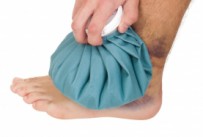Heat or Ice?

Heat or Ice?
Written by: Paul Kochoa, PT, DPT, OCS, CKTP, CGFI
My patients will often times ask me, “My [insert body part here] hurts. What should I put on it? Heat or ice?” Well, my answer is that it depends on the type of injury. First, let’s take a look at two different types of injury, their differences, and what your should apply to address each one.
There are two basic types of injuries when it comes to heat or ice: chronic or acute. Acute injuries are usually associated with some type of recent trauma, a sudden, painful event that lasts for 48-72 hours. Think of a twisted ankle or hitting your toe on the coffee table. On the other hand, chronic injuries develop slower over time, usually progressing from an untreated acute injury and are marked by a dull pain or soreness. Some examples are a repetitive movement injury like wrist pain while typing or back soreness from sitting too long. Generally, acute injuries are generally easier to identify because they are sudden and painful. Signs and symptoms include pain, tenderness, and swelling.
Application of heat or ice depends on the symptoms and what you want to accomplish with the modality. Effects of applying ice are: decreased muscle spasm, decreased pain, decreased blood flow initially, and decreased metabolic rate. Effects of applying heat are: decreased muscle spasm, decreased pain, increased blood flow initially, and increased metabolic rate.
Ice is the best treatment for acute injuries because of the primary benefits of reducing pain and inflammation. It can limit blood flow to the area and decrease bleeding. Apply ice to the affected area 10-15 minutes with compression and elevate the body part above the level of the heart if possible. You can apply ice several times throughout the day, but just be sure to give your body part sufficient time to return to regular temperature between applications.
Chronic injuries can benefit from a combination of heat and ice. Heat an area before activity or exercise, and ice an area after activity or exercise. Heat can be applied 15-20 minutes at a time, but make sure you have some layers between your skin and the heat source to prevent burns. Same thing goes for ice. The heat can increase blood flow to an area and increase the elasticity of the tissue, preparing the body part for activity. The ice can reduce any residual pain or swelling after the activity. But very important, never apply heat to an injury that is swollen or inflamed.
Seek medical attention if your injury is severely inflamed or does not improve in 48 hours. If you have any other questions, feel free to drop a comment here or ask your friendly neighborhood physiotherapist.
If you would like more information, please call Professional Physical Therapy and Training at 973-270-7417. Our offices our located within the YMCA locations in Madison and Summit, NJ. You do not need to be a member of the YMCA to visit with us.
Image courtesy of artur84 / FreeDigitalPhotos.net